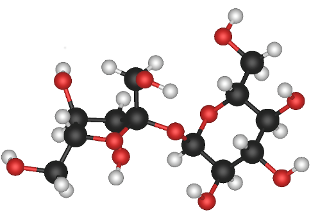Carbohydrate

Carbohydrates are molecules made of carbon, oxygen, and hydrogen.[2] As are all carbon-containing molecules, carbohydrates are organic molecules. Carbohydrates are usually made initially from photosynthesis, which is the process plants use to take in carbon dioxide, and is one of the most important ways of getting carbon dioxide out of the atmosphere (although not the only way). The chemical reaction to form carbohydrates takes some number of carbon dioxide molecules, adds the same number of water molecules, and makes a sugar with a chain of carbon atoms:[2]
n CO2 + n H2O CnH2nOn
The word comes from roots that mean 'watered carbon'. Carbohydrates usually have a ratio of two hydrogen for one oxygen (just like water) along with the same number of oxygen atoms and carbon atoms.[2] Many molecules that give energy to living organisms get that energy from some sort of carbohydrate, like sugars, starch, or cellulose.[3]
For more information about carbohydrates please see UC Davis's chem wiki.
References
- ↑ Akane700. (2006).Sucrose Molecule 3D Model[Online]. Available:http://simple.wikipedia.org/wiki/Sucrose#/media/File:Sucrose_molecule_3d_model.png
- ↑ 2.0 2.1 2.2 (2015, Jan. 7). ChemWiki: The Dynamic Chemistry e-Textbook [Online]. Available: http://chemwiki.ucdavis.edu/Biological_Chemistry/Carbohydrates/Carbohydrates
- ↑ (2015, Jan. 7). Carbohydrates [Online]. Available: http://hyperphysics.phy-astr.gsu.edu/hbase/organic/carb.html

